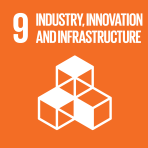 Industry, Innovation and Infrastructure
Industry, Innovation and Infrastructure
Forewords
The space sector has long stood as a beacon of innovation, exploration, and human achievement.
Understanding what works
From the data collected, SMEs who had achieved or surpassed parity (with 50 percent or more women overall) were largely comparable across a range of policy areas to those SMEs who had yet to achieve parity (with less than 50 per cent women overall).
Methodology
This research comprised a mixed methods qualitative and quantitative study undertaken from February to July 2025.
Space4Women Landmark Study on Gender Equality in the Global Space Sector
Phase 2: Experiences of Women in the Global Space Sector and Gender Representation and Policy Uptake in the Private Space Sector
Gender equality has a transformative impact on everything from individuals to institutions and innovations in the space sector. Despite this, the space sector has many data gaps when it comes to gender equality, hampering our ability to know what to do, and how to do it, and impacting individuals’ experiences in the sector. Gender inequality in the sector has broader implications for talent retention, recruitment, and the sustainable uses of outer space. This study builds on the Phase 1 Landmark Study on Gender Equality in the Global Space Sector and the UNOOSA Space4Women Expert Meetings in the Republic of Korea, Canada, and Kenya. This report comprises two parts, launching the UNOOSA Phase 2 research into gender equality in the space sector. The first part of this report focuses on women’s experiences in the sector, while the second part provides information on gender representation in private space organizations and examines policies or interventions that advance gender equality. The purpose of both is to drive transparency, action, and progress towards equality and inclusion in humanity’s ambitions in space. Not only is this critical to the Space2030 Agenda and the Sustainable Development Goals but it is also a moral and strategic necessity.
Literature review
The following provides an overview of the literature on gender equality in the space sector, with respect to 1) the experiences of women and 2) the represen-tation of women in the space sector.
Acknowledgements
The United Nations Office for Outer Space Affairs (UNOOSA) expresses its sin-cere appreciation to all women who contributed to this study by sharing their time, experiences, and insights into entering and advancing within the space sector, despite the numerous challenges.
Executive summary
Gender equality has a transformative impact on everything from individuals to institutions and innovations in the space sector.
Introduction
Understanding women’s experiences and representation in the space sector is vital.
Understanding what works
More than one in five participants (23 per cent) reported being aware of a solution/s to gender inequality in the space sector that worked.
Основа проекта
Прое кт «Устойчивая мобильность и интеллектуальные транспортные связи в странах Центральной Азии, на Кавказе и в Западных Балканах» направлен на поддержку государств-членов Экономической комиссии ООН для Европы (ЕЭК ООН) в переходе к устойчивой мобильности и умной связности.
Introduction
Le « Manuel d’épreuves et de critères » contient des critères, des méthodes d’épreuve et des procédures qu’il convient d’appliquer pour classer les marchandises dangereuses conformément aux dispositions des « Recommandations des Nations Unies relatives au transport des marchandises dangereuses, Règlement type », ainsi que les produits chimiques qui présentent des dangers physiques selon le « Système général harmonisé de classification et d’étiquetage des produits chimiques, SGH ».
